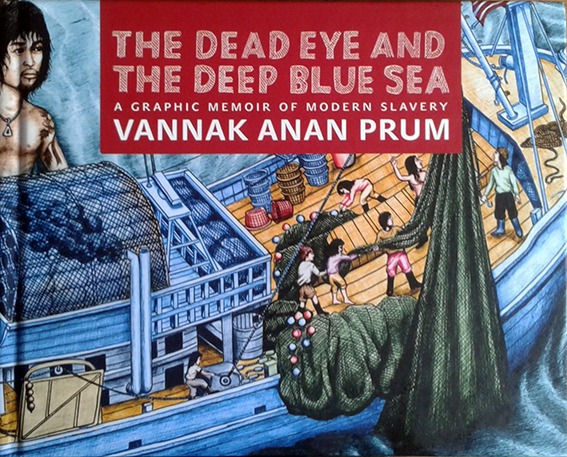A harrowing tale of slavery from the Cambodian graphic artist and author Vannak Anan Prum – the man who experienced it all
Long the go to place for ‘ex-pats who lunch’ mid-September found me in Phnom Penh’s Java Café, its fan adorned balcony providing a panoramic view of Hun Sen Park, its statute of King Norodom Sihanouk looking northward, seemingly unimpressed at the view of the inglorious monstrosity that is the Naga World casino. Inside, away from the street noise and the miasma of Phnom Penh, I navigated to the air-conditioned room that lies to the left of the upstairs entrance. Here, as my eyes adjusted to the low light, I was able to make out what I had travelled from Siem Reap to see.
Along the room’s walls hung a series of prints, some of them bright and colourful, others rendered in the more sobering lines of black and white. On these walls, a million miles away from the smells of coffee and polite conversation going on outside, the images documented a world of hardship and exploitation— a place of slavery—men hauling nets, sorting fish, trying to survive in a place where the shackles are the waters of the ‘deep blue sea’.
The origin artist of these images is Vannak Anan Prum, a Cambodian national who, unwittingly, found himself enslaved on a small vessel plying the fishing grounds of Southeast Asia.
As a child Vannak had enjoyed drawing pictures in the dirt outside his rural home (Bruce Lee was a favourite subject). This interest evolved into a skill that followed this remarkable individual into adulthood—a journey that saw him spend time as a monk, a soldier and then a farm hand.
But it is what happened after he left rural Cambodia for an alleged job in Thailand, five harrowing years at sea and on land as a slave, which is laid out starkly in The Dead Eye and the Deep Blue Sea, the book documenting these dark chapters in Vannak’s life.
The volume, described as a ‘graphic memoir of modern slavery’, is an astonishing body of work which, in 230+ pages of images and words, offers as much insight into modern slavery as any number of reports and conference proceedings can ever hope to do.
Some of these insights come by way of episodes that are truly harrowing. Take this experience from Vannak’s three and a half years at sea:
“One night I woke up needing a piss. I walked on deck toward the rope toilet at the stern and heard a strange noise nearby. It sounded like someone trying to kill a big fish. I crept to the end of the cabin and peeked around the corner just in time to see Kay cutting Dam’s head off with a cleaver.”
There are numerous similar stories scattered across the pages of The Deep Eye and the Deep Blue Sea , each one of them reinforcing the inhumanity that arises when people are treated as mere cogs in an exploitative economic machine.
Balancing out these episodes are depictions of the personal turmoil that Vannak endured over his half decade of enslavement – the hours spent longing for loved ones and home, the despair of not knowing if he would see either again, and the physical exhaustion experienced from long hours, with little sleep or food, of retrieving fishing nets and harvesting palm nuts.
That Vannak escaped his holders and was able to eventually return to his wife and child in Cambodia—at first his wife did not recognise him and doubted the story that this ‘strange man’ told of his recent life—means that he is one of the ‘fortunate’. At the same time he acknowledges psychological scars that match the physical ones from his ‘slave days’. And one suspects that translating his story into pictures and words has been an important part in his path back to normalcy.
A tale that is illuminating and tragic, Vannak’s survival and return home means that his story is also a triumphant one (in 2012 Vannak was presented with Human Rights Defenders Award for his work in documenting the fishing boat slave industry).
However one should not leave the final page of The Deep Eye and the Deep Blue Sea with the feeling that all is right with the world. The truth is much more sobering, for as Vannak and others have repeated and the recent Australian live-action film Buoyancy shows, millions remain locked in slave conditions across the globe (40 million by some counts) – not just on fishing boats, but also in factories, brothels and on plantations. In fact official records indicate that more people are enslaved today than in any other period in human history.
With this in mind the frozen fish section of your local supermarket may never look the same again.
Available at all stores of Monument Books
